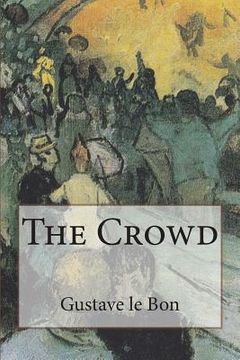Reseña del libro "The Crowd (en Inglés)"
The Crowd: A Study of the Popular Mind is a classic and fascinating crowd psychology study authored by Gustave Le Bon and first published in 1895. In the book, Le Bon claims that there are several characteristics of crowd psychology: "impulsiveness, irritability, incapacity to reason, the absence of judgement of the critical spirit, the exaggeration of sentiments, and others..." Crowd psychology, also known as mob psychology, is a branch of social psychology. Social psychologists have developed several theories for explaining the ways in which the psychology of a crowd differs from and interacts with that of the individuals within it. Major theorists in crowd psychology include Gustave Le Bon, Gabriel Tarde, Sigmund Freud, and Steve Reicher. This field relates to the behaviors and thought processes of both the individual crowd members and the crowd as an entity. Crowd behavior is heavily influenced by the loss of responsibility of the individual and the impression of universality of behavior, both of which increase with the size of the crowd. The psychological study of crowd phenomena was documented decades prior to 1900 as European culture was imbued with thoughts of the fin de siècle. This "modern" urban culture perceived that they were living in a new and different age. They witnessed marvelous new inventions and experienced life in new ways. The population, now living in densely packed, industrialized cities, such as Milan and Paris, witnessed the development of the light bulb, radio, photography, moving-picture shows, the telegraph, the bicycle, the telephone, and the railroad system. They experienced a faster pace of life and viewed human life as segmented, so they designated each of these phases of life with a new name. They created new concepts like "the Adolescent," "Kindergarten," "the Vacation," "camping in Nature," "the 5-minute segment," and "Travel for the sake of pleasure" as a leisure class to describe these new ways of life. Likewise, the abstract concept of "the Crowd" grew as a new phenomenon simultaneously in Paris, France, and Milan, the largest city in the Kingdom of Italy. Legal reformers motivated by Darwin's evolutionary theory, particularly in the Kingdom of Italy, argued that the social and legal systems of Europe had been founded on antiquated notions of natural reason, or Christian morality, and ignored the irrevocable biology laws of human nature. Their goal was to bring social laws into harmony with biological laws. In pursuit of this goal, they developed the social science of criminal anthropology, which is tasked with the mission of changing the emphasis from one of the study of legal procedures to one of studying the criminal. "Criminal anthropology," writes Signor Sergi, "studies the delinquent in his natural place, that is to say, in the field of biology and pathology". The Italian Cesare Lombroso, professor of forensic medicine and hygiene in Turin, greatly advanced their agenda in 1878, when he published L'uomo delinquente, a highly influential book which went through five editions. The book, published in English in 1900 under the title "Criminal Man," solidified the links between social evolutionary theories and the fear of crowds with its concept of the "born" criminal as the savage in the midst of civilized society. The book influenced both European and American legal experts interested in assigning responsibility to individuals engaged in dubious behavior while engaged within a crowd.

